|
 Nederlands /
Dutch Nederlands /
Dutch
Bumblebees belong to the order Hymenoptera. The other insects, which belong to this order, are bees, wasps, ants and saw flies (Symphytae).
Bumblebees
Big hairy bees of the genus Bombus. They live in colonies. Only the queen hibernates and starts a new colony next year. The nest is sometimes underground, but can also be built between clumps of grass.
The larvae feed on pollen and nectar. The pollen are collected in the pollen basket or corbicula on the hind legs.
The males have long antennae. Besides the queen and males there are also workers. (Not so many as in the colonies of honey bees)
I haven't described al possible colours. On this site you can get much more information:
http://www.nhm.ac.uk/
|
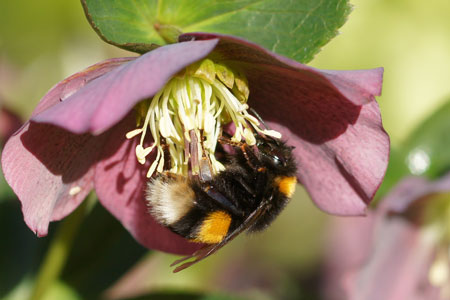 ... ...
 . .
 Large Earth Bumblebee, Buff-tailed Bumblebee (Bombus terrestris). Photos 21-3-2014.
Large Earth Bumblebee, Buff-tailed Bumblebee (Bombus terrestris). Photos 21-3-2014. |
|
The Buff-tailed Bumblebee is in the Netherlands very similar to the white-tailed bumblebee
(Bombus lucorum), the rarer Bombus magnus and the rarer Bombus cryptarum. Queens and workers with a
small brown yellow collar on the front edge of the thorax are easiest to
identify as Buff-tailed Bumblebee. If the collar is broader, it is more difficult. Males are
the most difficult to identify.
Collar and second segment of the abdomen are orange or golden yellow. Point abdomen is white.
Queen Length 20 to 28 mm, worker 11-17 mm length and length male 14-16 mm.
Nest in the ground. It may be more than one meters below the ground. The large earth bumblebees are among the first
bumble bees to appear in spring. Queens: late February, early March.
German: Dunkle Erdhummel. French: Bourdon
terrestre.
|
|
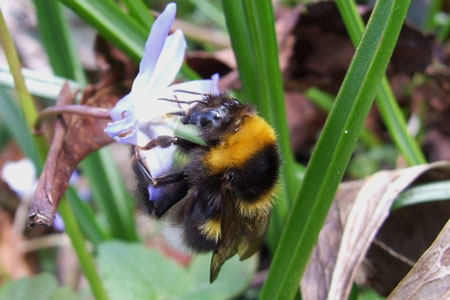 ... ...
 Garden Bumblebee (Bombus hortorum). Photo
The small photo14-6-09, a male
Garden Bumblebee (Bombus hortorum). Photo
The small photo14-6-09, a male |
|
The Garden Bumblebee is rather similar to the Large Earth
Bumblebee. The main difference is the band behind with yellow hairs. The
band is as well on the abdomen as on the back of the thorax. Divided in two
bands.
Garden bumblebees have the longest tongue. It can forage on flowers that have deep
corollas like the mint family and the legume family, pea family.
Nest on the ground or undergrounds. For example in mice nests and bird nests.
About up tot 100 bumblebees.
Length queen 18-26 mm, length workers 11-16 mm, length male 13-15
mm. Flight: March-September
German:
Gartenhummel French: Le Bourbon des jardins.
|
|
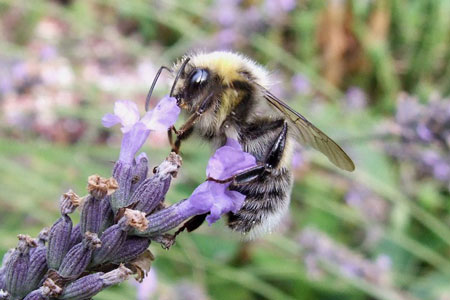 ... ...
 White-tailed bumblebee
(Bombus lucorum).
White-tailed bumblebee
(Bombus lucorum).
|
|
Pale yellow collar and second abdominable segment.
Black first abdominal segment and scutellum. Black hairs often have white tips. (as
on this photo)
Queen Length 19-22 mm, length male 13-16 mm.
Flight: March to October. Like the Large Earth Bumblebee it is an early
bumblebee. Nest in the ground.
German: Hellen / helle Erdhummel
|
|
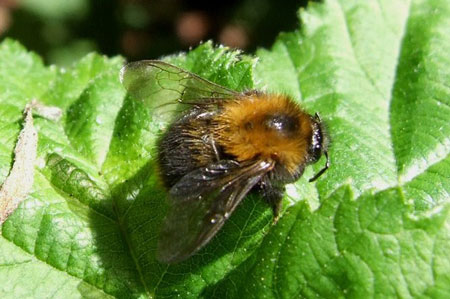 ... ...
 .
Common Carder Bee (Bombus pascuorum). Photos
9-4-2010, queen .
Common Carder Bee (Bombus pascuorum). Photos
9-4-2010, queen |
|
The thorax is orange brown. The abdomen is black with a
orange brown dot.
On this photo the end of the abdomen is not visible. When it has a
white-ended abdomen, it is the tree bumblebee (Bombus hypnorum).
Queen: Length 15-18 mm, length male 12-14 mm, length worker 9-15 mm.
Flight: April to October. Nest on or in the ground. Also in bird nests.
German: Ackerhummel French: Bourdon des
champs
|
|
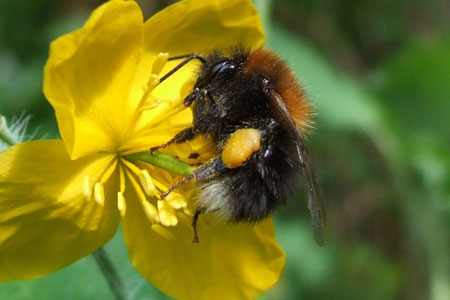 ... ...
 . .
 New garden bumblebee, tree bumblebee
( Bombus hypnorum).
Photos 30-4-2010.
New garden bumblebee, tree bumblebee
( Bombus hypnorum).
Photos 30-4-2010. |
|
The thorax is orange brown. The abdomen is black with a white dot.
Length queen 18 to 22 mm, length male 14 to 16 mm, length daily 8 to 18 mm.
Flight: April to August. (Queens February to late April, workers in April to mid-August, young queens and males in May to late August)
Nest above the ground. In many holes, in bird nests in nest boxes. 80-400 workers.
Most of Europe and parts of Eastern Asia.
German:
Baumhummel French: Bourdon
des arbres
|
|
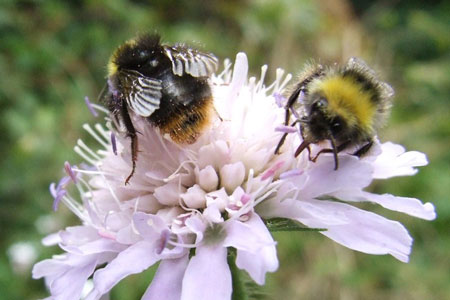 ... ...
 . .
 Early Bumblebee
(Bombus pratorum). Early Bumblebee
(Bombus pratorum). |
|
A small bumblebee. Collar yellow. The tail is orange red. The yellow bar in the middle of the
abdomen can be absent or reduced to a few hairs.
It has a short tongue. Flying time: March to October. Not as early as the Large Earth Bumblebee.
Queen Length 15-17 mm, length male 11-13 mm.
The nest can be in the ground and above the ground. It also can be found. in
mice nests, birdhouses and bird nests
German: Wiesenhummel:
|
Cuckoo Bumblebees belong to the sub genus Psithyrus.
The females lay their eggs in a bumblebee nest.
She kills host eggs, larvae and oft the queen. The cuckoo bumblebee larvae
develop into pupae and adults in the nest. So they are parasitic bumblebees.
They lack the pollen baskets on the legs
|
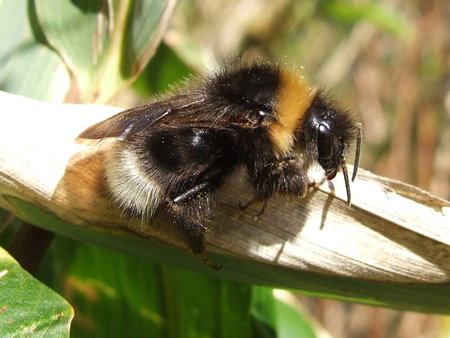 ... ...
 . .
 Bombus
bohemicus. Probably, I am not quite sure. Photos 14-4-2010, female Bombus
bohemicus. Probably, I am not quite sure. Photos 14-4-2010, female |
|
Similar species are Bombus
vestalis and Bombus
norvegicus. A
yellow collar. Point abdomen is white.
A parasite of the White-tailed bumblebee
(Bombus lucorum) But also of other bumblebee species.
March-September. Length female 14-20 mm, male 12-18 mm.
German:
Angebundene Kuckuckshummel
|
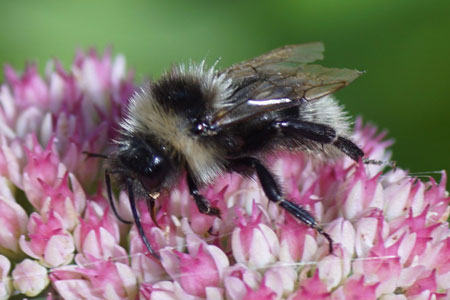 ... ...
 Field Cuckoo Bumblebee (Bombus campestris). manle
Field Cuckoo Bumblebee (Bombus campestris). manle
|
A yellow-haired back and golden yellow hairs on the sides of the black abdomen tip. Hairs of the male in the photo are more whitish.
The most important host in the Netherlands is probably the Common Carder Bee pascuorum.
April-October, the males from the beginning of May. Length female 17-22 mm, male 15-17 mm. Photos
14-9-2021. German:
Feld-Kuckuckshummel
|
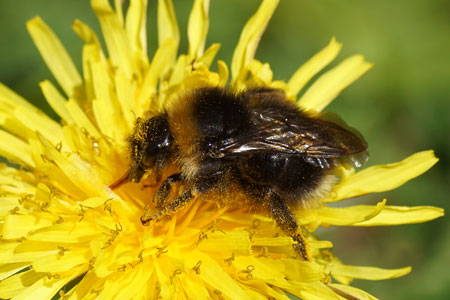 Forest cuckoo bumblebee, four-coloured cuckoo bee (Bombus
sylvestris) or Bombus norvegicus. Photo 28-4-2021. Female
Forest cuckoo bumblebee, four-coloured cuckoo bee (Bombus
sylvestris) or Bombus norvegicus. Photo 28-4-2021. Female
|
forest cuckoo bumblebee, four-coloured cuckoo bee (Bombus sylvestris). Common. The females have a shiny abdomen and
thin hair. The thorax has a wide ocher yellow band and the third back
plate has white hair.
The main hosts are Bombus pratorum and Bombus jonellus. Often like in this
photo on dandelion.
March-October. Length female 15-18 mm, male 12-15 mm.
Bombus norvegicus. Rare. Looks a lot like Bombus sylvestris.
The main host is Bombus hypnorum.
April-August.
|
Another site with information: http://www.bwars.com/Gallery.htm
I want to thank everyone, who has helped me on waarneming.nl and forum.hymis.de
to identify.
Nederlands /
Dutch
 
Subpage flies:
Tachinidae
Blow-flies
(Calliphoridae) House
flies (Muscidae) Soldierflies
(Stratiomyidae) Root-Maggot
Flies (Anthomyiidae) Small
flies Gnats
Subpage wasps, bees, bumblebees: Parasitica, Ichneumonidae
Sawflies
symphyta Leaf-cutter bee
Subpage France: Insects
France
|
